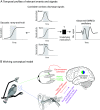Parametric information about eye movements is sent to the ears
- PMID: 37988462
- PMCID: PMC10691342
- DOI: 10.1073/pnas.2303562120
Parametric information about eye movements is sent to the ears
Abstract
Eye movements alter the relationship between the visual and auditory spatial scenes. Signals related to eye movements affect neural pathways from the ear through auditory cortex and beyond, but how these signals contribute to computing the locations of sounds with respect to the visual scene is poorly understood. Here, we evaluated the information contained in eye movement-related eardrum oscillations (EMREOs), pressure changes recorded in the ear canal that occur in conjunction with simultaneous eye movements. We show that EMREOs contain parametric information about horizontal and vertical eye displacement as well as initial/final eye position with respect to the head. The parametric information in the horizontal and vertical directions can be modeled as combining linearly, allowing accurate prediction of the EMREOs associated with oblique (diagonal) eye movements. Target location can also be inferred from the EMREO signals recorded during eye movements to those targets. We hypothesize that the (currently unknown) mechanism underlying EMREOs could impose a two-dimensional eye-movement-related transfer function on any incoming sound, permitting subsequent processing stages to compute the positions of sounds in relation to the visual scene.
Keywords: coordinate transformations; otoacoustic emissions; reference frames; saccades; sound localization.
Conflict of interest statement
Competing interests statement:The authors declare no competing interest.
Figures







Similar articles
-
Individual similarities and differences in eye-movement-related eardrum oscillations (EMREOs).Hear Res. 2023 Dec;440:108899. doi: 10.1016/j.heares.2023.108899. Epub 2023 Oct 30. Hear Res. 2023. PMID: 37979436 Free PMC article. Review.
-
Detection of Spatially Localized Sounds Is Robust to Saccades and Concurrent Eye Movement-Related Eardrum Oscillations (EMREOs).J Neurosci. 2023 Nov 8;43(45):7668-7677. doi: 10.1523/JNEUROSCI.0818-23.2023. Epub 2023 Sep 21. J Neurosci. 2023. PMID: 37734948 Free PMC article.
-
Eye movement-related eardrum oscillations do not require current visual input.Hear Res. 2025 Sep;465:109346. doi: 10.1016/j.heares.2025.109346. Epub 2025 Jun 28. Hear Res. 2025. PMID: 40614487
-
Conserved features of eye movement related eardrum oscillations (EMREOs) across humans and monkeys.bioRxiv [Preprint]. 2023 May 22:2023.03.08.531768. doi: 10.1101/2023.03.08.531768. bioRxiv. 2023. Update in: Philos Trans R Soc Lond B Biol Sci. 2023 Sep 25;378(1886):20220340. doi: 10.1098/rstb.2022.0340. PMID: 36945629 Free PMC article. Updated. Preprint.
-
Eye movements and scene perception.Can J Psychol. 1992 Sep;46(3):342-76. doi: 10.1037/h0084328. Can J Psychol. 1992. PMID: 1486551 Review.
Cited by
-
Individual similarities and differences in eye-movement-related eardrum oscillations (EMREOs).Hear Res. 2023 Dec;440:108899. doi: 10.1016/j.heares.2023.108899. Epub 2023 Oct 30. Hear Res. 2023. PMID: 37979436 Free PMC article. Review.
-
Conserved features of eye movement related eardrum oscillations (EMREOs) across humans and monkeys.Philos Trans R Soc Lond B Biol Sci. 2023 Sep 25;378(1886):20220340. doi: 10.1098/rstb.2022.0340. Epub 2023 Aug 7. Philos Trans R Soc Lond B Biol Sci. 2023. PMID: 37545299 Free PMC article.
-
Detection of Spatially Localized Sounds Is Robust to Saccades and Concurrent Eye Movement-Related Eardrum Oscillations (EMREOs).J Neurosci. 2023 Nov 8;43(45):7668-7677. doi: 10.1523/JNEUROSCI.0818-23.2023. Epub 2023 Sep 21. J Neurosci. 2023. PMID: 37734948 Free PMC article.
-
Eye movements track prioritized auditory features in selective attention to natural speech.Nat Commun. 2024 May 1;15(1):3692. doi: 10.1038/s41467-024-48126-2. Nat Commun. 2024. PMID: 38693186 Free PMC article.
References
-
- Groh J. M., Sparks D. L., Two models for transforming auditory signals from head-centered to eye- centered coordinates. Biol. Cybernetics 67, 291–302 (1992). - PubMed
-
- Boucher L., Groh J. M., Hughes H. C., Afferent delays and the mislocalization of perisaccadic stimuli. Vis. Res. 41, 2631–2644 (2001). - PubMed
-
- Metzger R. R., Mullette-Gillman O. A., Underhill A. M., Cohen Y. E., Groh J. M., Auditory saccades from different eye positions in the monkey: Implications for coordinate transformations. J. Neurophysiol. 92, 2622–2627 (2004). - PubMed
-
- Fu K. M., et al. , Timing and laminar profile of eye-position effects on auditory responses in primate auditory cortex. J. Neurophysiol. 92, 3522–3531 (2004). - PubMed
MeSH terms
Grants and funding
LinkOut - more resources
Full Text Sources

